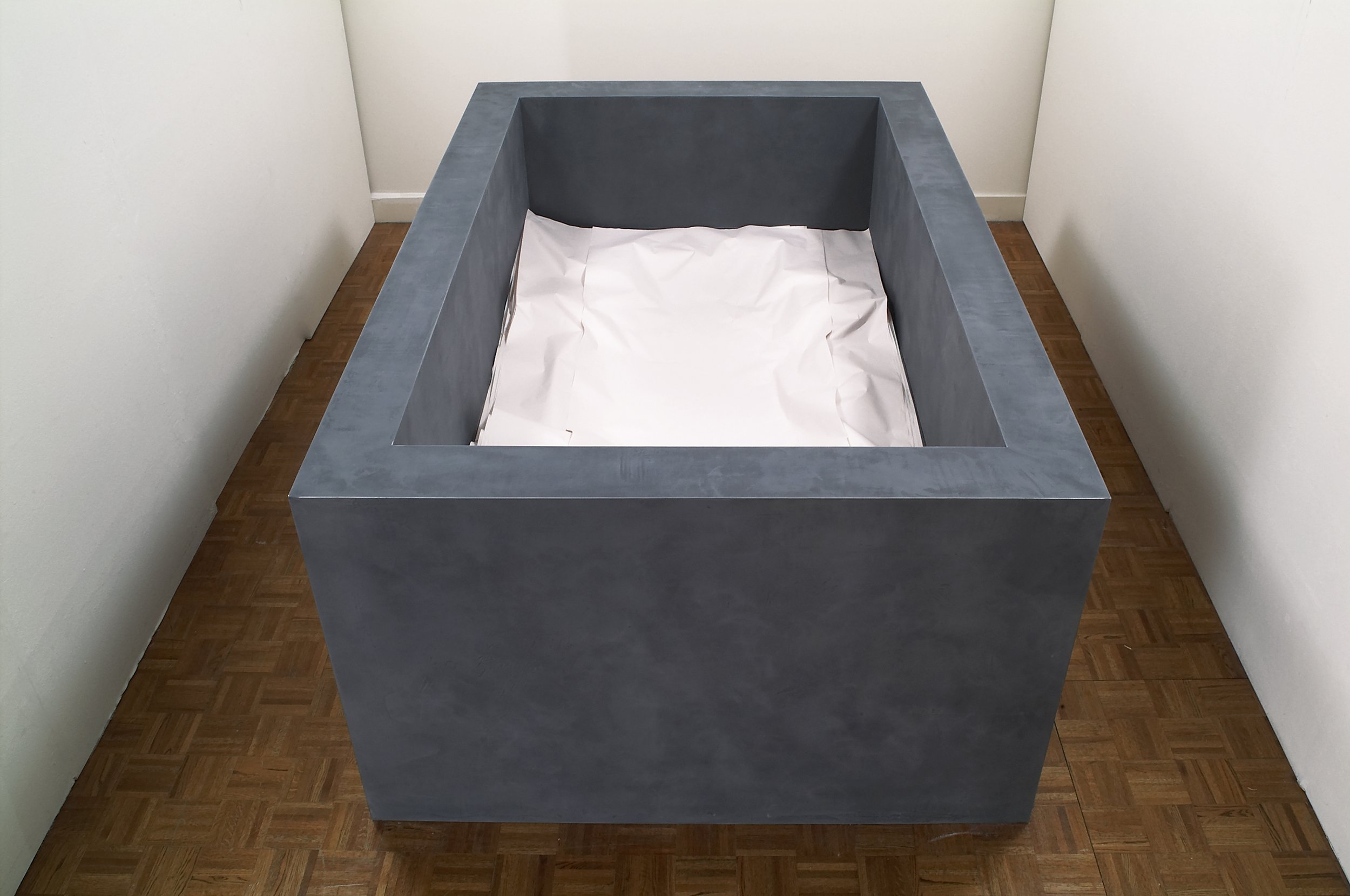Lethe Room
above: Lethe Room, view of the work as part of Monika Weiss - Five Rivers, an early retrospective exhibition at Lehman College Art Gallery, City University of New York, 2005-2006. curated by Susan Hoeltzel. Photographic documentation by Hermann Feldhaus
Lethe Room
2004
motorized sculpture: plaster, metal, wood, motor, paper, residue of pigment and graphite, 80 x 120 x 40 inches
performance: the artist lies down on top of the hundreds of layers of paper marking it with graphite and dry pigment
series of aerial photographs based on performance, dimensions variable, limited edition, 3 + 2AP
below: selected aerial photographs, limited edition, 2 + 2 AP
below: view of Lethe Room, with performance by Monika Weiss at Lehman College Art Gallery, CUNY, December 2005
Credits
created, choreographed, designed and performed by Monika Weiss
sculpture produced at the studio of Brendan Atkinson
motor designed by Mark Esper
production support: Remy Toledo Gallery, New York and Galerie Samuel Lallouz, Montréal
Artist Statement
I lie inside a rectangular container, which resembles a stone tomb. Inside, hundreds of thin sheets of paper move gently under the pressure of my body. My hands hold chunks of graphite and dry pigment. I mark the sheets, cutting through their delicate surfaces as lines appear gradually around my body. The viewers have been asked to remain silent. One hears the paper crackling, shimmering like the waters of a remote river. In Orphism, a Greek mystical religious movement, it was believed that those who drank from the River Lethe would lose all memory of their past existence. In a separated enclosed space resembling a cell, an 80 x 120 x 40 inches rectangular sculpture is positioned centrally, leaving a narrow space to walk around it. The sculpture is made of wood, metal and plaster, with a hidden motor located in its base. Hundreds of layers of newsprint paper are enclosed in the vessel. The paper material is set in continuous motion, resembling a breathing organism, suggesting the presence of someone or something moving underneath. I designed the sequence of movement based on a 3-minute fragment of music composed by Hildegard von Bingen. Several times on selected days throughout the exhibition I inhabited this installation. My body lying inside the vessel shaped the papers, while traces and marks left by the pigment and graphite gradually changed the color and texture of the layers of paper. The piece exists equally with and without my body, at the same time a site of presence and absence.
- Monika Weiss
Essay Excerpt
For Weiss, drawing is less a process of deliberate mark-making than an intuitive, emotional and sensorial act. For Lethe Room (2004), the artist sculpted a vessel reminiscent of a rectangular sarcophagus that was filled with layers of paper upon which the artist laid down. Holding chunks of graphite, Weiss slowly made marks on the papers’ delicate surfaces, leaving traces of her presence that was further eerily amplified when the paper began to move after the artist had left. Weiss translated a fragment of a composition by the twelfth-century composer Hildegard von Bingen into a mathematical system that would set the motor and sensors installed in the vessel in motion in a rhythm resembling breathing. The work forged a poetic connection that attempted to fuse the sounds and rhythms of the body with the physicality of drawing. The Indian poet Meena Alexander noted in relation to Weiss’ practice that it is marked by ‘a meditative embodiment of what lines or images cannot spell out: the impalpable’, a quality that structures works like Lethe Room. Weiss’ embodied practice foregrounds the sensorial as a modality through which we can develop an ethics and politics of remembrance and of being in the world, simultaneously challenging modernist assumptions concerning the duality of mind and body. Many of Weiss’ works include performative actions in which the artist keeps her eyes closed for several hours, delinking from the over-emphasis on vision as the primary sense structuring aesthetic experience and as a vehicle of secular reason, cemented by European Enlightenment.
- Katarzyna Falęcka, in Monika Weiss - Nirbhaya, Centre of Polish Sculpture in Orońsko, 2021
Exhibitions
Monika Weiss - Intervals, Remy Toledo Gallery, New York, 2004, curated by Asher Remy-Toledo
Monika Weiss - Five Rivers, Lehman College Art Gallery, City University of New York, 2005-2006, curated by Susan Hoeltzel
Publications
Sculpture Today 4. ANTI-Monument: Non-traditional Forms of Commemoration, Centre of Polish Sculpture in Orońsko, Poland, 2020
Drawing Now: Between the Lines of Contemporary Art, Loughborough University, Loughborough, Great Britain, 2008
New Realities: Being Syncretic, Springer, New York/Vienna, 2008
Monika Weiss - Five Rivers, Lehman College Art Gallery, City University of New York, in collaboration with Galerie Samuel Lallouz, Montréal, 2007
Meena Alexander’ poem Aletheia (Girl in River Water) was first written in response to Monika Weiss’ Lethe Room and published in the artist’s monograph Monika Weiss - Five Rivers, Lehman College Art Gallery, 2007. The poem was subsequently slightly revised and published in Alexander’s book of poetry Quickly Changing River: Poems, Northwestern University Press, 2008:
Meena Alexander, Aletheia (Girl in River Water) [2005] in Quickly Changing River: Poems, Northwestern University Press, 2008, originally written after seeing Monika Weiss’ performance in Lethe Room







